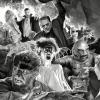|
MONSTERS FAN ART GALLERY #05 |
Updated: June 04, 2023




































































































Carl Laemmle Jr. saw the future in 1931 and the future looked scary. The son of Universal Pictures founder Carl Laemmle, the junior Laemmle had served as the studios head of production since 1928, helping the studio transition to the talkie era and earning
acclaim for efforts like All Quiet on the Western Front and Waterloo Bridge. Those efforts didnt always translate into profits for
Universal, which would prove a problem for Junior, and Universal, later in the decade but in 1931, both found tremendous success by unleashing a string of horrors on an unsuspecting moviegoing public. Dracula, with its chilling lead performance by the
Hungarian-born Bela Lugosi, arrived in February. Frankenstein, featuring the English-born Boris Karloff as the mad scientists
stitched-together creation, followed in November. Karloff returned in The Mummy in 1932, followed by Claude Rains as The
Invisible Man in 1933.
That remarkable early 30s run debuted one now-iconic movie character after another, the collaborative work of the films stars; directors Tod Browning, James Whale, and Karl Freund; the studios in-house writing talent; and makeup and effects wizards like
Jack Pierce and John P. Fulton. It also established the trademarks of a Universal monster movie, combining macabre atmospheres and shocking flashes of violence sometimes the object of censorship with monsters that were often as pitiable as they were scary
and stories that tapped into deeper themes of death, compulsion, and insanity. It buoyed the studios fortunes ( for a while ) and helped make Universal synonymous with horror.
|
 HOME
HOME
 About
About
 EMail Me
EMail Me TOP |
TOP |  PREVIOUS ITEM | NEXT ITEM
PREVIOUS ITEM | NEXT ITEM  ( 5 of 11 )
( 5 of 11 )




































































































